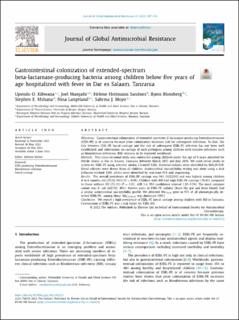Gastrointestinal colonization of extended-spectrum beta-lactamase-producing bacteria among children below five years of age hospitalized with fever in Dar es Salaam, Tanzania
Kibwana, Upendo O.; Manyahi, Joel; Sandnes, Helene Heitmann; Blomberg, Bjørn; Mshana, Stephen E.; Langeland, Nina; Moyo, Sabrina John
Journal article, Peer reviewed
Published version

Åpne
Permanent lenke
https://hdl.handle.net/11250/3040120Utgivelsesdato
2022Metadata
Vis full innførselSamlinger
- Department of Clinical Science [2379]
- Registrations from Cristin [10237]
Originalversjon
Journal of Global Antimicrobial Resistance. 2022, 30, 107-114. 10.1016/j.jgar.2022.05.023Sammendrag
Objectives: Gastrointestinal colonization of extended-spectrum β-lactamase-producing Enterobacteriaceae (ESBL-PE) is of concern because prior colonization increases risk for subsequent infections. To date, the link between ESBL-PE faecal carriage and the risk of subsequent ESBL-PE infection has not been well established, and information on carriage of such pathogens among children with invasive infections such as bloodstream infections (BSI) remains to be explored worldwide.
Methods: This cross-sectional study was conducted among children under the age of 5 years admitted for febrile illness in Dar es Salaam, Tanzania, between March 2017 and July 2018. We used rectal swabs to screen for ESBL-PE using selective media, ChromID ESBL. Bacterial isolates were identified by MALDI-TOF. Blood cultures were drawn from all children. Antimicrobial susceptibility testing was done using a disk diffusion method. ESBL alleles were identified by real-time PCR and sequencing.
Results: The overall prevalence of ESBL-PE carriage was 56% (112/200) and was highest among children 4 to 6 months old (17/21, 81%) (P = 0.05). Children with BSI had high ESBL-PE carriage (78.4%) compared to those without BSI (53.1%) (P = 0.02; aOR 3.4, 95% confidence interval 1.20–9.58). The most common isolate was E. coli (64/112, 45%). Sixteen pairs of ESBL-PE isolates (from the gut and from blood) had a similar antimicrobial susceptibility profile. We detected blaCTX-M gene in 97% of all phenotypically detected ESBL-PE; among those, blaCTX-M-15 was dominant (99%).
Conclusion: We report a high prevalence of ESBL-PE faecal carriage among children with BSI in Tanzania. Colonization of ESBL-PE was a risk factor for ESBL-BSI.
